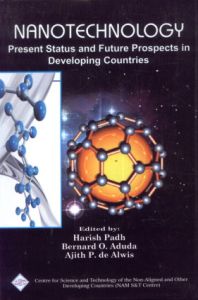
Contents: Foreword/Yoginder K. Alagh. From the Editors’ Desk/Harish Padh, Bernard O. Aduda and Ajith P. de Alwis. Introduction/Arun P. Kulshreshtha. I. Characterization and synthesis of nanomaterial: 1. Nanostructures, nanomaterials and sytems/U.S. Tandon. 2. The morphological study of different architectures of (Dimethylamino) Ethyl Methacrylate polymer at Nano scale for gene delivery/Nagib A. Elmarzugi. 3. Synthesis of Nano Size anatase type of Titania aerogels by addition of Silica/Silvester Tursiloadi. 4. Development of nanostructured smart delivery systems for pesticides and fertilizers/Erastus Gatebe and Harrison Wanyika. 5. Characterizationof Carbon Nano Particles (CNPs) formed in diluted environment/Alsayed Ali. 6. Growth and characterization of PbS nanocrystalline thin films deposited on glass substrates by chemical bath deposition/Iyad Ali, Nofal Ibrahim, Louay Mansour and Abdel Karim Sharba. II. Applications of nanotechnology: 7. Global scenario of nanotechnology/Y.K. Agrawal. 8. Detection of explosives using nanotechnology/Vinod Kumar Jain. 9. Drug delivery and drug targeting using therapeutic nanoparticles/Ranjit Jagadale, Niraj Sakhrani and Harish Padh. 10. The ICPC Nanonet Project/Linsey Robertson. 11. Application of Nano-science and nanotechnology in Uganda’s economy/Henry M. Bazira. 12. Complementary use of uRBS, uPIXE, AFM and SEM in studying the interaction of germanium with iridium and Palladium in lateral diffusion couples/A. Habanyama, Zambia and C.M. Comrie. III. Nanotechnology: status and prospects in developing countries: 13. Nanotechnology: present status and future prospects in Armenia/Vladimir Aroutiounian. 14. The Cuban approach towards Nanobiotechnology: a new step on scientific development of the country/Ariel Felipe. 15. Nanotechnology: present status and future prospects in Indonesia/Silvester Tursiloadi. 16. An overview on Nanotechnology activities in Iran/Saeed Sarkar and A. Beitollahi. 17. Status of nanoscience and nanotechnology in Kenya/Bernard O. Aduda. 18. A vision for civic engagement in nanotechnology in Mauritius/Hemraj Ramsurrun. 19. Present status of nanotechnology research in Mynmar/Moe Zin Win and S. Theingi. 20. Nanotechnology: present status and future prospects in Nigeria/Hammanga. 21. Sri Lankan nanotechnology initiative/Ajith P. De Alwis.
Nanotechnology is the understanding and control of matter at dimensions between approximately 1 and 100 nanometres, where unique phenomena enable novel applications. Encompassing nanoscale science, engineering, and technology, nanotechnology involves imaging, measuring, modeling, and manipulating matter at this length scale. Increased energy efficiency, a cleaner environment, more effective medical treatment and improved manufacturing production are just some of the potential benefits of nanotechnology. Biologists, chemists, physicists and engineers are all involved in the study of substances at the nanoscale. Bio-nanotechnology allows the production of new materials and devices including fabrics and cellular engineering scaffolds, molecular motors and biomolecules for the delivery of drugs, sensors of wide spectrum and other medical applications. Nanotechnology offers new engineering tools that can help us address the design problems associated with building better implants. In the context of biomedical engineering, recent technological advancements mean that we now have the ability to manipulate materials with nanometer scale accuracy. This allows us to create biomaterials with features the same size as the proteins and cells with which our implant interest. Nanomaterials may also be used as active sensing elements or receptors, as transducing components (e.g. electro-or chemo-mechanical actuators), and even as electrodes in electronic circuitry and power systems (e.g. nanowires). Developments in this field are taking place at a very high speed. In view of these factors all the developing and developed countries are aspiring to establish strong base for nanotechnology R&D and production.
In order to review state of the art research and development in nano-scale phenomenon, devices, systems and manufacturing, the NAM S&T Centre along with the Iranian Research Organization for Science and Technology (IROST), Iranian Nanotechnology Initiative Council (INIC) and IOR-ARC Regional Centre for Science and Technology Transfer (RCSTT) organized an international workshop on Nanotechnology present status and future prospects in developing countries from 18-20 May 2009 at Kashan, Iran. Scientists from developing and developed countries actively participated in its deliberations. The latest developments in the areas related to nanoscience and nanotechnology were reviewed by well-known experts besides presentation of several country report. This publication includes 21 articles and review papers on various aspects of nanotechnology and would be useful for the nanotechnology researchers, experts and practitioners in this fast emerging field.